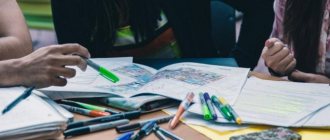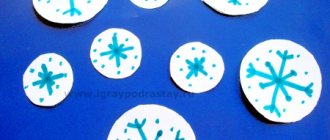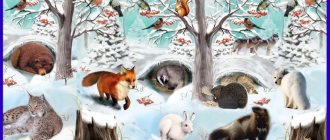Preview:
Objectives: to arouse interest in the image of streams. Learn to draw wavy lines (horizontally). Practice brush painting techniques. Develop a sense of form and rhythm. Cultivate interest in natural phenomena and curiosity. Preliminary work. Outdoor game "Let's jump over the stream." Geometric mosaic games. Materials and equipment: Sheets of paper for each child, paints, brushes, napkins. Progress of the OOD The teacher shows the children a paper boat and reads A. Barto's poem "The Boat": Sailor's hat, Rope in hand, I pull the boat along a fast river, And the frogs jump at my heels And ask me: - Give me a ride, captain! The teacher creates a problematic situation. The ship cannot set sail, since there are no streams, and invites the children to help the boat. The teacher asks the children to show with their hands how the boat floats on the water. Children (by imitating the actions of the teacher) depict a wave - “draw” wavy lines in the air - first with one hand, then with both hands synchronously. Before class, the teacher suggests playing with your fingers. Finger game "Boat"
A boat is sailing along the river,
He swims from afar, (fold your arms like a boat and make wave-like movements)
There are four on the boat
A very brave sailor. (show 4 fingers raised up)
They have ears on the top of their heads (raise our hands to the head, show the ears with bent palms)
They have long tails (put your hand to the lower back, pretend to move the tail)
But only cats are scary to them,
Only cats and cats. (raise both hands to the head, draw cat claws and hiss) After the game, the teacher invites the children to draw streams so that the boat can set sail. After the children have drawn streams, the teachers place a basin of water on the table and lower the boats into the water. Exhibition of works.
Progress of OOD
Educator: Morning has come.
The sun has risen...On such a clear, sunny day, don’t you children want to go anywhere? Of course, for a walk. And what will we meet there?
Children: The sun. Birdie. Spring.
Educator: Of course Spring. Spring is coming, spring is in a hurry. Streams run over the hummocks...
Educator: Where did the streams come from in the spring?
Children: The sun warmed up brightly, the snow melted and streams .
Educator: What do streams ?
Children: On the wave, like on the sea.
Educator: What floats on the waves?
Educator: Let's draw waves in the air with our fingers.
And then take the paint with your fingers and draw rivulets on a sheet of paper .
Educator: What color are our streams ?
(The teacher invites the children to dip their finger in blue paint and use their finger to draw a wavy line - a stream .)
Educator: Pay attention to the picture, what are the children doing in the picture?
Children: they are launching boats.
Educator: Now we’ll play with boats. (I hand out paper boats to the children)
.
Educator: What did we do today in the group? What interesting things did you learn? What should we tell mom at home? Show with your hand what waves you drew? (Children draw a wavy line with their hand)
.
Children: Well, we’ll eat along the waves, along the waves...
Summary of the lesson on artistic creativity “Let's draw a sleeping bear” Alena Chernyavskaya “Artistic creativity. Let's draw a sleeping bear. » Purpose: To strengthen children’s ability to draw a sleeping (lying) animal, observing.
GCD summary for artistic creativity “The snowball is fluttering and spinning...” GCD summary for the educational field “Artistic Creativity” in the first junior group on the topic: “The snowball is fluttering and spinning.” Target -.
Summary of a lesson on artistic creativity “Sun in the Sky” Objectives: Teach children to use a cotton swab, gouache, water, and a napkin. Learn to create an expressive image of the sun. Call out bright.
Summary of a lesson on artistic creativity “Snowman-postman” Summary of a lesson on artistic creativity junior group No. 5 “Friend” Topic “Snowman-postman” Purpose: • Improve technical skills.
GCD summary for artistic creativity “Mimosa for Mom” GCD summary for artistic creativity on the topic: “Mimosa for Mom” Integration of educational areas: “Artistic creativity”.
Abstract of an open lesson on artistic creativity “Flowers from foamiran” Direction of education and development (educational field): artistic - aesthetic, cognitive. Goal: Teach children how to make.
Abstract of the OOD on artistic creativity “Mug for Dad” in the middle group Artistic creativity drawing in the preparatory group “Mug for Dad” Purpose: teaching the decorative design of a mug. Tasks: call.
Summary of a lesson on artistic creativity and manual labor “Hedgehogs” Purpose: -To develop children’s interest in modeling, working with natural materials, and independent creativity. Objectives: -To reinforce practical skills in children.
Summary of the OOD lesson on artistic creativity (drawing) in the middle group “Autumn Tree” Topic: Autumn tree. Goals: - continue to teach children to draw a tree, conveying its characteristic features: the trunk, diverging from it.
Lesson notes on artistic creativity “Watch Workshop” Lesson notes Educational activity: Artistic creativity (Design) on the topic: “Watch Workshop” In the preparatory room.
Source
On the topic: methodological developments, presentations and notes
Summary of a drawing lesson on the topic: “Leaf fall” in the first junior group. Topic: "Leaf fall." Goals: - continue to teach children to become familiar with colors: yellow, red, green; .
This lesson is aimed at reinforcing the basic colors, the concept: one-many. Through the active game “My funny ringing ball” and through productive activities (drawing), children receive the necessary knowledge.
Joint drawing by an adult and a child in the first junior group from 2 to 3 years old Topic: “Chickens in the meadow.”
Summary of a comprehensive lesson on drawing and speech development in the first junior group. Topic: Let's draw an elegant costume for parsley. Goals: Teach children to draw with fingers (pillow) select.
Notes on drawing with elements of appliqué in the first junior group “Hide the Bunny” Goal: Goal: to consolidate the technique of painting with a brush using the “dipping” method. Software for.
SUMMARY OF DIRECT EDUCATIONAL ACTIVITIES ON AWARENESS WITH THE ENVIRONMENT AND SPEECH DEVELOPMENT USING ICT IN THE FIRST JUNIOR GROUP “What grows where?” Goal: to form in children p.
Goal: - To teach to notice the beauty of nature in autumn, to introduce children to such a natural phenomenon as leaf fall. - To continue to teach children to familiarize themselves with colors: yellow, red, green; - To introduce children to brushes, .
Source
Preview:
State Treasury Institution of Health Care
"Specialized psychoneurological children's home No. 13
SUMMARY OF DIRECT EDUCATIONAL ACTIVITIES
Educational field: artistic and aesthetic development.
Pedagogical technology: health-saving
Age category: 3rd year
Krekina Svetlana Viktorovna
Goal: to arouse children’s interest in creativity for the purpose of their artistic and aesthetic development.
Educational (continue to learn how to paint with a brush, paints, squeeze water from a brush on the edge of a jar of water, draw carefully, implement your plans on paper).
Developmental (consolidate the signs of spring as a season).
Educational (cause an emotional response to your work and the work of other children, learn to evaluate your work (it worked or not).
Preliminary work: Reading fiction, looking at paper boats, getting to know the signs of spring as a season.
Form of organization: individual.
Methods and techniques: Play, conversation - dialogue, physical exercise, practical activity, joint activities with children.
Materials and equipment: landscape sheets (1/2 A4), brushes, jars of blue gouache, jars of water, rags, flat image of boats according to the number of children.
Introductory part: 2 minutes
— Greetings in poetic form
Main part: 15 minutes
— Acquaintance with the time of year and its signs
— A surprise moment (the appearance of a cat toy)
— Physical exercise to P. Voronko’s poem “Pie”
— A teacher’s conversation with children about how snow melts and streams flow
Final part: 3 minutes
— Consolidation of what has been learned (children name the signs of the onset of spring)
— The teacher hands out paper boats and invites the children for a walk.
Greeting: “Hello, golden sun, hello, blue sky, hello, light breeze, hello, sunny day. Hello my friends, I’m glad to see you all!”
Educator: Guys, what time of year is it outside the window?
Educator: How did you realize that it was spring outside?
Children: It’s getting warm outside, the snow is melting.
Suddenly there is a noise and a soft toy kitten flies into the group (as if it jumped in on its own).
Educator: Oh, who came to us?
Educator: I found out that this is my familiar kitten. His name is Ryzhik. What happened to you, Ryzhik?
Guys, Ryzhik tells me that he is in a hurry. Look, he brought a cup with him. There is snow in the cup. Ryzhik decided that since there was a lot of snow outside, he could not buy flour, but bake snow pies. Do you think it is possible to bake snow pies?
Educator: Now the guys and I will tell you a poem about one cat who also wanted to bake snow pies.
Children and the teacher recite P. Voronko’s poem “Pie” while standing at the chairs, accompanying the show. Performs the function of a physical minute. Snow fell on the threshold, the cat made himself a pie, and while he was sculpting and baking, the pie flowed away in a stream. Bake your own pies, not from snow - from flour!
Educator: Guys, why didn’t the cat succeed?
Children: The snow has melted.
Educator: Where did we watch the snow melt and streams flow?
Educator: You see, Ryzhik, you won’t succeed, you’ll still have to use flour for pies. But don't be sad. Now the guys and I will draw streams and tell you about one spring fun.
The children are seated at the tables.
Educator: There was so much water on the street that in the spring it began to gather in streams and flow through the streets.
Children draw streams.
Educator: Guys, what wonderful streams we have. But it seems to me that our paintings will be even more interesting if we add paper boats to them.
The teacher hands out paper boats to the children.
Educator: I want to give my painting to Ryzhik so that he will look at it and remember us.
Bottom line. At the beginning of the lesson, we talked about the fact that it’s spring outside the window. What signs of spring can you name?
Children: The sun is getting very hot, birds are flying in from warmer climes, snow is melting and streams are flowing, animals are waking up after hibernation.
Educator: And we are launching boats! I invite you all to let the boats go for a walk today.
The teacher shows pre-prepared paper boats.
Lesson “Ball for a kitten” (painting)
Tasks:
- continue to teach children to draw round objects with pencils and carefully paint over them;
- strengthen children's knowledge of the main colors;
- cultivate enthusiasm for drawing.
Progress of the lesson:
A kitten's plaintive squeak is heard. The teacher asks the kids:
-Who is crying so pitifully?
- Kitty.
The teacher asks the kitten:
- What's happened?
And the kitten knows that he has lost his beloved ball and cannot find it anywhere. Then the teacher invites the children to look for the ball. The kids look for the kitten's ball and don't find it.
- How can we help the kitten? (draw with pencils)
- What shape is the ball? (round)
The teacher gives the children sheets with pictures of kittens on which they will draw balls.
At the end, the kids look at the work.
Lesson “It’s snowing” (painting with snow-white paint)
Target:
- develop children’s ability to draw snow with the tip of a brush;
- learn how to sketch over the entire surface;
- introduce the color snow-white;
- cultivate independence and perseverance.
Progress of the lesson:
- Kids, a monkey came to visit us, she lives in a warm country, and it has never snowed here, she will soon go home and wants to take the snow with her and show it to the other monkeys.
- Let's help her.
The teacher shows the children the snow brought from the street, the kids watch how it melts.
- What should we do anyway? Let's draw how the snow is falling.
The kids look out the window at the falling snow.
fall from the sky in winter
And they circle above the earth
The teacher encourages the kids to draw with the tip of the brush all over the sheet. Reminds children how to pick up paint, remove excess paint on the edge of the container, and be careful when working.
At the end of the work, the teacher points out the children's work to the monkey, praises the kids for good work, the kids take part in examining the work, evaluating who got the most snow.
The teacher invites the children to show the monkey their group and introduce them to their favorite toys.
At the end, the monkey says goodbye, thanks all the kids and confiscates the work.
Lesson “Vitamins” (drawing with pencils)
Tasks: continue to teach kids to draw small circles sparingly along the entire contour of the bottle;
- consolidate knowledge of the yellowish color, the ability to correctly hold and draw with a pencil;
- cultivate perseverance and independence.
Progress of the lesson:
The teacher tells the children about the benefits of vitamins and that they are very necessary in winter, especially when people often get sick.
— Do you all have vitamins at home? What are they? (Kids answer)
— Do you think our dolls need vitamins? (Kids answer “Yes”)
- But bad luck, they have absolutely no vitamins left! (The teacher points to an empty jar of vitamins) Shall we help them, kids?
The teacher hands out paper silhouettes of jars and invites them to draw as many vitamins as possible.
At the end, the kids take the containers filled with vitamins to the dolls. The dolls thank the kids.
On the topic: methodological developments, presentations and notes
A lesson using non-traditional painting techniques without a brush.
Create conditions for displaying impressions in children’s artistic activities.
Summary of direct educational drawing activities on the Topic: “Sun” for younger preschool age. The summary indicates the purpose, objectives and structure of the lesson.
Outline of a drawing lesson (junior group) on the topic: Summary of the educational activity “Green onions”.
The summary is designed to enrich the content of children's visual activities.
Unconventional drawing with palms in the 2nd junior group of kindergarten.
laquo;Beautiful cart for a horse"summary of a drawing lesson junior groupObjectives:• Strengthen the ability to use a brush correctly (right.
Source
Summary of educational activities for visual activities in the early age group (2–3 years) “First streams”
Alevtina Soboleva
Summary of educational activities for visual activities in the early age group (2–3 years) “First streams”
Goal: to develop the ability to paint over the entire sheet by drawing horizontal lines from left to right. Continue to develop the ability to hold a brush correctly and use the working material carefully. To develop the ability to distinguish and name color (blue, size (long)
. Develop interest in natural phenomena.
Equipment: a sheet of paper with a pattern showing through - boats (with a candle, wax applied on a sheet of paper with an image of a boat , blue gouache, brush No. 6, containers with water, stand for brushes.
Preliminary work: introducing children to the season - spring . Observing the characteristic signs of spring while walking (sun, warmth, snow, streams , boats launching.
Abstract of the OOD on artistic creativity “Streams are running, babbling”
Lyudmila Shaulskaya
Abstract of the OOD on artistic creativity “Streams are running, babbling”
OOD in the early age group “ Streams are running , babbling... ”
.
Shaulskaya Lyudmila Pavlovna.
Goal: to promote the development of children's creativity .
Objectives: learn to draw wavy lines horizontally, practice finger drawing.
Arouse interest in depicting streams in collaboration with the teacher and other children.
Cultivate interest in natural phenomena.
Material: sheets of paper,
Plates with blue paint.
Boats to play with,
Painting “Children launching boats”
.
Preliminary work: observations in nature, making paper boats.




